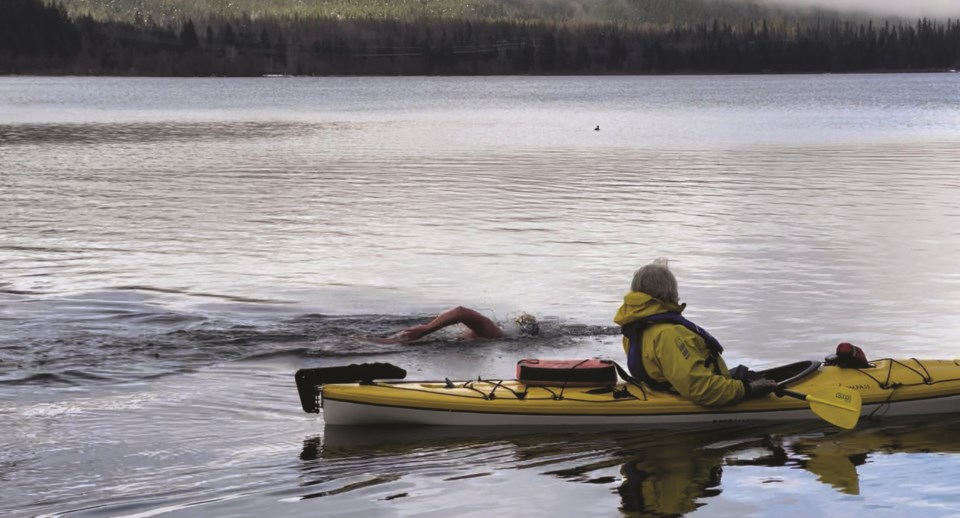It’s late November, the air is getting cooler, and the snow is here to stay. The temperature is hovering around 5 C and you step out of step onto the shores of Alta Lake wearing nothing but a bathing suit and make your way towards the water.
There’s slush floating on top, but that doesn’t stop you. You step in the water and submerge your body. The first few minutes are spent controlling your breathing and getting over just how shockingly cold being in 3 C water is. From there you start swimming.
Minutes pass and you continue to swim, body now aching, strokes slowing down and extremities numb, but you stick with it. Approximately 30 minutes pass and you’ve finally reached your goal of an “ice mile.” You emerge from the lake, but the challenges are just beginning.
Now comes the rewarming process. Your body starts to shake and shiver, you need to get out of your wet clothes and into some dry ones, but your body is so weak and numb you can’t do it yourself. Finally, with help from a friend, you are dry and you make your way to a warm vehicle where you sit in the warmth and try not to panic as your core temperature slowly climbs back up to normal, while still not being able to move or think at a regular pace.
This is what Jessi Harewicz went through on Nov. 26 to complete her second-ever ice mile.
A Vancouver-based marathon swimmer, Harewicz first got into doing ice miles as a way to train her mind and body for her upcoming attempt to swim the North (Irish) Channel between Scotland and Ireland next year.
But when asked why subject yourself to such extremely cold water when the Channel is going to be more than three times warmer, she cited the famous quote, often mis-attributed to Sir Edmund Hillary but first spoken by George Mallory, when asked why climb Everest … “Because it’s there.”
“I began ice swimming sort of for the same reason why I started marathons, which is, we have the water. We have the water to train for the English Channel (which she has already completed) at least eight months of the year here, and we have the water to train and ride down the temperatures for ice miles. It’s just not done,” said Harewicz.
“It’s there, it’s possible, and I do it because it’s adventure, it’s fun, and I wanted to learn what it was like to feel that cold. We have little control over life with exception of our own breathing. In ice swimming, your breath is everything and it gives me a sense of power to have control of my body under extreme conditions.”
However, just because it is possible, doesn’t mean an ice mile is something that should be taken lightly or done on a whim. It takes hours of training and preparation and an entire team to attempt an ice mile safely.
Joining Harewicz for her ice mile attempt in November was her swimming partner Roberta Cenedese, who also completed an ice mile with Harewicz last December at Alice Lake. Harewicz’s father kayaked beside the swimmers, ready at a moment’s notice to help them get to shore if need be. Also on the water were official observers—including Christine Burns—who are tasked with monitoring the swimmer’s condition and making the call to pull the swimmer from the water if they decide it’s necessary.
“To swim an ice mile you have to have qualified and proven that you are capable of swimming in those cold waters. So with Jesse and Roberta, I was trusting in their abilities to be able to do it because cold water is dangerous in that the swimmer can become disoriented and not recognize they are in distress,” said Burns, who also included hypothermia as one of the major risks.
“We generally try to watch the stroke rate of their swimming, and then, with the course, we set up laps and at each turnaround point we make them talk to us so they have to coherently say a given sentence, and if they can’t remember, if they don’t know what it was, if they are slow then that’s an indicator that something is going on with them.”
That exact situation happened to Cenedese during the swim when, at about the halfway mark, she knew she was supposed to say something to the observers but couldn’t remember what. So instead of taking the risk, she decided to end her swim at one kilometre, while Harewicz finished the full mile.
And while certain intermittent cold exposure methods like the one Wim Hof made famous, have been proven to give many mental and physical benefits like increased energy, better sleep and improved mood, ice miles don’t fall into the same category.
According to Harewicz, they offer none of the same mental or physical benefits that a quick dip in an icy lake does.
Ice miles are carried out around the world, and the sport has it’s own governing body, the International Ice Swimming Association. The next World Championship is to take place in Glogow, Poland in early February.



